Today we begin our look at the team's participating in the 2010 Vancouver Olympic Men's Ice Hockey Tournament, starting with the lowest seeded team in Group C, Germany.
The Germany National Ice Hockey Team is currently ranked 12th in the IIHF World Rankings and is coming off a dismal performance in the 2009 World Championships, where they finished 15th out of 16 teams and only avoided relegation due to an IIHF stipulation that ensures their participation at the Top Division as hosts of the 2010 tournament in May.
Based on their status outside the top nine ranked countries, Germany was obligated to participate in the Olympic Qualification process, a series of tournaments that date back to September of 2008. The host Germans were able to advance to the main tournament in Vancouver by going undefeated in their group which consisted of Japan, Slovenia and Austria.
The Germans have participated in the Olympics in ice hockey 20 times since 1928, with nine of those being as Germany. Three of the teams were called the United Team of Germany during the split between East and West Germany in 1956, 1960 and 1964, but it was actually just the West Germany Team, which defeated the East German team for the right to represent all of Germany as one "United" team.
Following that ill-fated "united" concept, Germans have also participated seven times as West Germany and once as East Germany in 1968, the only time West Germany and East Germany both sent teams to the same Olympic Games.
Their best results have been bronze medals in 1932 as Germany and in 1976 as West Germany.
Aside from their poor showing in 2009, the Germans are regular participants in the World Championships, having been in the Top Division of the World Championships every year since the reunification of Germany in 1991 except three, with two of those years earning promotion back to the Top Division. Their best finish during that time period was a 5th place in 1993. While not considered one of the elite countries in hockey, they are just outside of the top group and have been invited to participate in the eight team World Cup of Hockey both times it has been held.
Germany enters the 2010 Olympics with seven NHLers on its roster, including Thomas Greiss of San Jose, Christian Ehrhoff of Vancouver, Dennis Seidenberg of Florida, Marcel Goc of Nashville, Jochen Hecht of Buffalo and Marco Sturm of Boston. Surprisingly, Christoph Schubert of Atlanta, a past Olympian, was left off the squad. Look for him to possibly be added if there are any roster adjustments due to injury leading up to the games, as was he case with Hecht.
Hecht, in fact, was one who missed the 2006 Olympics in Torino, Italy, due to suffering an injury in the final NHL game prior to the Olympics. Sturm, who as to captain the team, also pulled out with an injury just prior to Torino, scuttling any hopes for success the Germans had in 2006 as they finished 10th out of the 12 teams.
A challenge for Germany, which faces many of the lower ranked countries when naming their teams is one of loyalty, as the team the competes in the Olympic Qualification Process seldom include players otherwise unavailable due to their NHL commitments.
"It's a bit of a tightrope act," said Uwe Krupp said Germany's coach and general manager. "We can't simply take all our NHL players because they're NHL players. What about the guys who were here all through the qualification process and got us into the Olympics?" Do I tell them to just step aside? We have ten players in the NHL and AHL, but none of them took part in qualifying," Krupp said, referring the qualification tournament in Hanover, Germany last February that got Germany into the Olympics with narrow 2-1 wins over Austria and Slovenia using a roster composed entirely of players that were domestically based in the German hockey league, the DEL.
"it could be disruptive if I left off some of the guy who battled to get us into the Olympic," Krugg said, "and whatever chance of success we have in Vancouver will be the result of our whole team, not a few individuals."
Since Germany did not dominate their qualification group, they seem to be in no position to put loyalty ahead of talent and would do themselves a huge favor by bringing the most talented squad possible to Vancouver in order to compete with teams at level of Sweden, Finland and Belarus who make up the rest of Group C.
While they are not expected to win a medal, their performance in Vancouver is an opportunity to create some excitement leading up to the 2010 World Championships, for which they are hosts. The tournament will kick off May 7th with a game against the United States at the Vetlins Arena, a soccer stadium with a retractable roof, expected to be played in front of a world record crowd of 76,000.
Today's featured jersey is a story all it's own.
It is a Nike 1999 Germany National Team Michael Bakos jersey worn in the 1999 World Junior Championships B Pool. In the collecting hobby it is known as "The Double Eagle" jersey, due to it originally being designed for the 1998 Nagano Olympic Games with the eagle head on the crest facing to the left.
The jersey design began in the summer of 1996 in order to meet production deadlines for the summer of 1997 six to nine months prior to the Olympics in February of 1998. At the time, such reference options as GettyImages.com or the image search functions found on Google or Yahoo did not exist and the designer used books in the Nike sports library for inspiration. Photos were found of a German long jumper from he late 70's as well as a crowd shot from a German National Team soccer match.
The eagle head in the long jumper photo was oriented to the athlete's left and the waving flags held by the soccer fans were seen from both sides, and as a result, the eagles were seen facing both left and right. The long jump photo in particular, lacked any signage or numbering of any sort to give a clear indication of the orientation of the original photo.
Other reference materials showed the eagle heads facing both ways and the designer proceeded to orient the eagle head to the left as shown in the photo of the long jumper.
Of note, the eagle was given four feathers on its wings to distance the Nike produced jerseys from the familiar, iconic three-stripes of competitor Adidas.
The Nike legal department, the German Ice Hockey Federation (the DEB) and the German culture office of the government all signed off on the design of the jersey, which included the logo, and it then went into production.
Press photos were then released of the jersey with the left facing eagle crest, shown here modeled by national team goaltender Olaf Kolzig.
Then the phone rang at Nike customer service...
Someone, reportedly from the southern United States, perhaps near Atlanta, claimed the left facing eagle was the style used by the Nazi party in World War II and the proper eagle now would only be one that faced to the right.
Meetings were called and the designer was questioned about the design and why it faced to the left. A German employee at Nike backed up the designer, saying it was fine that way and it was pointed out that not only had the Nike legal department approved it, but so had the Germans, including a branch of their own government, where one would expect sensitivities to Nazi imagery would be at its highest.
Still, not wanting to risk any bad publicity, due to concerns at the time over sweat shops in Asia producing Nike goods and recent issues Reebok had undergone with Muslims over a clothing design, it was decided to alter the jerseys to re-orient the eagle so that it would now be looking to the right.
A new set of right-facing eagle patches were quickly manufactured and sewn over the original dye-sublimated logo prior to the Olympics in February. None of the jerseys were sold at retail with the over-patching, so all of the "double eagle" jerseys in existence are game worn examples.
Below is a comparison of the embroidered right-facing eagle crest and the original sublimated left-facing crest hidden underneath the embroidered version sewn over it.
Incidentally, a quick search on Google Images for "Nazi eagle emblem" will show a split between eagles facing both right and left, clearly indicating no distinct preference and a likely majority of the ones we believe to be authentic to the 1940's at first glance actually facing to the right!
Here is a look at the jerseys that Germany will be wearing in the 2010 Olympics in Vancouver. The always attractive German jerseys most unique feature is the eagle from their main crest ghosted on the lower sleeves of their jerseys.
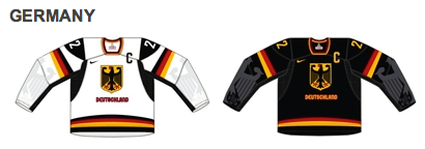
Dasherboard: For those of you who did not read yesterday's look at the format for the Olympic tournament, this year's format is a bit complex in places and somewhat difficult to explain quickly and easily, but it does have some ramifications on how the early part of the tournament will be played that we feel is important.
The format calls for three groups, A, B and C, which consist of four teams each, playing a round robin of just three games in the Preliminary Round. At the conclusion of the Preliminary Round, all the teams will be ranked 1-12, in order of;
- higher position in the group
- higher number of points
- better goal difference
- higher number of goals scored
- better 2009 IIHF World Ranking
The top four teams will then receive byes into the Quarterfinals with the remaining eight teams, ranked 5-12, being paired off in the Secondary Round, which consists of four knockout games to be played on February 23rd, with the winners advancing to the Quarterfinals against the top four teams, which will be played the very next day, February 24th.
The discrepancy between there being three groups but four byes into the Quarterfinals is an unfortunate choice of format, which was chosen to compress the tournament into a shorter time frame than the 16 team, four group format of the World Championships.
Regrettably, the format of the tournament is stacked against the weaker teams, like Norway, as the top teams will be looking to pour it on in the preliminary round since the short schedule of just three games in the Preliminary Round puts a greater emphasis on goal differential which will undoubtedly be a factor to determine who gets the coveted bye into the Quarterfinals between the three second place finishers, as well as the most favorable matchup in the secondary round on February 23rd for a berth in the Quarterfinals.
In plain English, expect the top team in each group to finish the preliminary round with a 3-0 record and second place teams in each group to finish at 2-1. Therefore, the all-important tie breaker then becomes goal differential, encouraging, if not requiring, the top countries to kick the living snot out of the weaker ones.
For example, assume the United States, the Czech Republic and Finland each finish second in their groups with a 2-1 record. It will be in the United States best interest to try to pummel Norway 10-1 in the hopes that a +9 difference in goals will be enough to overcome the Czech's ability to pound Latvia and Finland's ability to crush Germany, since the one team able to outscore the other teams in its group by the greatest margin, will get an all important extra day off heading into the Quarterfinals before having to face one of the other two who will have just played an extra game the day before.
The way the tournament is structured, and the resulting emphasis on goal differential, is unfortunate in the way it rewards the team who can clobber the weaker ones the most, which flies in the face of the sprit of goodwill, sportsmanship and Olympic ideals.
It is really too bad that the Olympic tournament is not in the 16 team format of the World Championships, where the second round of the tournament is an additional round of group play for all surviving teams, without the incentive of byes presented which only encourage greater lopsided scores as a way to earn the byes offered in the Olympic format.
The same argument also applies to the winners of each group. Assuming they all go 3-0, their tiebreaker will also be heavily weighted toward goal differential, with the team achieving the best differential drawing the weakest opponent of the three during the Quarterfinals, which now means two teams each looking to clobber Norway, Lativa and Germany in the Preliminary Round. Say, for example all the favored teams advance out of the Secondary Round except for one upset by Latvia over Switzerland. A better goal differential would mean the difference between playing Latvia instead of Finland in the Quarterfinals based primarily on your ability to score 14 times against Germany a week earlier.

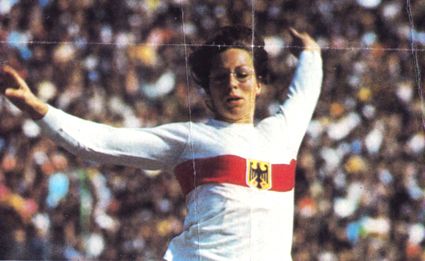

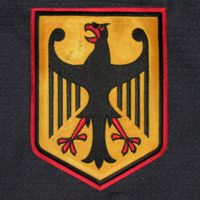 AAA
AAA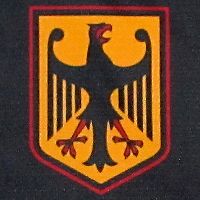
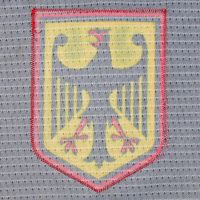



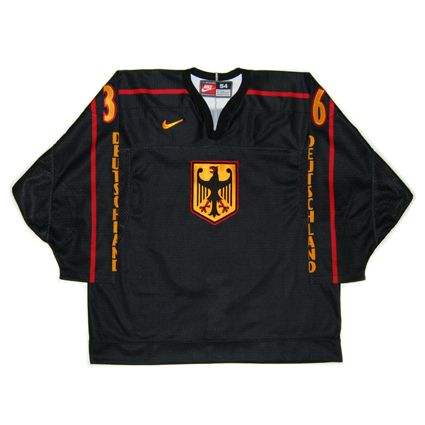
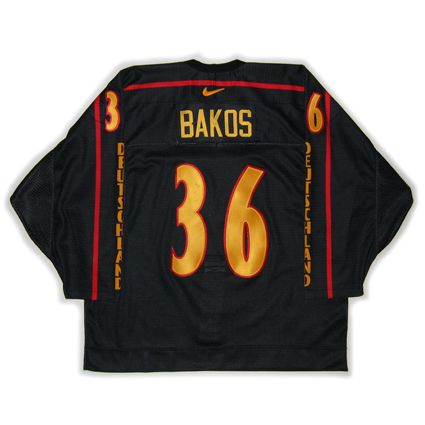










No comments:
Post a Comment
We welcome and encourage genuine comments and corrections from our readers. Please no spam. It will not be approved and never seen.